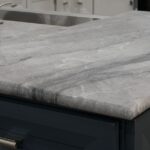Quartzite is a marvelous stone. It’s beautiful, natural, and probably one of the toughest stones out there. It’s the perfect fit for a countertop, especially for a kitchen. So, if you plan on adding quartzite to your kitchen, you may be wondering: does quartzite stain?
If you’re adding a new surface to your kitchen, it’s important to know if it will stain or not. This way, you can be prepared to act in case something falls on it. Cleaning it up immediately after something falls is a good way to prevent stains. But if the surface stains too easily, it may be a better idea to consider using some other material, or at least a slab prepared in a different way.
So, in this article we’ll talk a bit about quartzite and how it handles stains.
Does quartzite stain easily?
In general, no. But that depends a lot on the sealer.
Every quartzite slab comes with a protective layer called a “sealer”. The sealer can be made of many materials, but it’s usually either natural wax or some kind of plastic, like polyurethane or acrylic.
As quartzite is a natural stone, this protective layer also gives it a nicer, smoother look, along with a smoother surface, while not detracting from the stone’s beautiful natural patterns.
However, while quartzite makes for one of the hardest stones around, the sealer is not nearly as hard. Being made of plastic or wax, it can scratch easily, and over time it starts to wear off, leaving the stone underneath more vulnerable.
So, while the sealer is still new, there is no risk for quartzite to stain, as the materials used to seal it can be washed easily and are not prone to staining. However, if the sealer is already wearing out, then there is a higher risk for the stain to seep into the stone itself.
So, along with quickly wiping away spills and food residue, and cleaning up your countertop every day, it’s also important to reseal from time to time. This way, you can keep it looking nice for a long time.
If you noticed a stain in the stone, no need to worry. If you need to, you can also get it polished and resealed. Polishing the slab will remove the topmost part of the stone, which will remove the stain along with it. There are some other methods you can try out before resorting to it, but polishing will always give the best results.
Why is quartzite sealed?
While natural stone has its charm, it also has some problems when compared to engineered stone. With quartzite, this problem is porosity.
Quartzite is formed from the compression of sandstone over long periods of time. And sandstone is itself a compression of grains of sand. This compression allows the grains of sand to get closer and more connected to each other. This makes them harder and more resistant, while also making the stone progressively less porous.
However, “less porous” does not mean “not porous”. Quartzite can have many degrees of porosity, depending on which part of the world it comes from. It being porous means that it’s prone to drag in liquids, which means It’s prone to form stains that won’t come off easily.
So, while quartzite is by itself a very hard and durable stone, harder even than granite, with regular use it starts to lose its charm, as it can easily absorb any kind of dirt and residue.
So, to solve that issue, quartzite slabs are always sealed before being installed. The sealing job protects the stone from stains, making it look better for much longer. It’s also much easier to clean than the stone itself. And sealing and resealing is much easier, faster and cheaper than polishing it every time it gets a tough stain.
How likely is it for my slab to stain?
As different kinds of quartzite and sealers offer different kinds of protection, you’ll only know that if you test it yourself.
You can do this using stuff you find at home. If you’re still selecting the slab, get a sample for testing. If you already bought it, pick a spot that people aren’t likely to see (maybe the underside of the slab, if you can turn it upside down).
Then, get some acidic substances, or stuff that’s likely to leave a stain, like vinegar, wine, coffee, lemon juice, orange juice, and toothpaste. Put a drop of each of them on the slab and leave it for some time. Then, wipe it away.
If there was some kind of color change under a drop, such as dullness, color stains or discoloration, then that substance is prone to staining that kind of slab.
This is a good way to select where to put the countertop too: if stuff you find in a kitchen is more prone to stain it, then maybe it’s a good fit for the bathroom. If toothpaste stains it more easily, maybe it should go in the kitchen. Or even somewhere else where you’re planning on having a stone countertop.
What can I do if my quartzite countertop gets stained?
It’s always important to clean up anything that might stain the slab as soon as you see it touching the stone. However, if a stain formed, and you didn’t notice it in time, there are some things you could try.
Poultice may be able to clean it. It’s a kind of solvent that’s used specifically for porous stones, as it can get into the pores and pull the dried stain products out of them. However, it can be a bit hard to use correctly and can take a long time to give results.
If you’re lucky, though, the stain may have gotten into the sealer only, leaving the stone mostly intact. In this case, a resealing job should do the trick.
If the stain went deeper, then polishing and resealing the slab may be your only option. It’s a bit more expensive, but it will certainly give the best results.
If you want to know more about quartzite, or want to get rid of a stain on your countertop, be sure to contact us! We specialize in stone countertops, and we’ll be able to help you out.



